Missed Part One: Micro Jigging?
Last month I introduced you to a cutting edge style of fishing called micro jigging. It was a pretty in-depth introduction to micro jigs and the rods and reels required to make this specialised style of fishing work. This month I will follow on with a look at the assembly of the free swinging hook, knots and connections, plus the benefits of braided lines and leader material.
An important development in micro jigging was the refinement of the standard hook. The assist hook was born of necessity and joined the other advances that have been made to bring every aspect of micro jigging to the edge of perfection.
The assist hook does just that, it assists in hook-up rates and allows sustained hook holding capabilities due to its configuration. The assist hook comprises of a wide gape hook spliced to a short, looped Kevlar cord. This gives the hook a free swing and can have a varying length to suit different size jigs.
Having a jig that predominantly weighs more than most other lures of its size can have a negative affect when a fish is trying to dislodge the hook. This is counteracted by a system that incorporates each point of contact in the connection to be independent giving a straight line of pull from leader through to the attached hook and puts the weight of the jig out of the fighting equation.
The system consists of a little bit of terminal tackle and as a micro jigger you will need a supply of various size split rings and solid rings. Firstly, a solid ring is attached to the Kevlar loop of the assist hook and this in turn is attached to a split ring along with another solid ring that the leader will eventually be tied to. The jig is then connected and the system is complete.
A quick re-cap: leader tied to solid ring and connected, assist hook looped to a solid ring and connected then the jig gets connected to the one split ring and it’s all systems go! At the centre of the system the split ring and the three other components can all move independently on the split ring.
Most jiggers will connect the jig on the water minutes prior to the first drop because if the jig is already on the system it can really do some damage to rods in transit. It is for this reason that when rigging prior to a trip it pays to have all your assists assembled with added solid and split rings and just tie-on when ready to go.
Depending on size and brand of the assist, the hook position will usually lay behind the head and around the belly area of the jig. This is an area proven to be targeted by predatory fish and positioning the hook here leads to greater hook sets.
To increase hook sets you also need to make sure the hook is wider than the jig so that the hook point is exposed. This also helps prevent the hook wedging itself around the jig stopping hook sets altogether.
Another benefit of the assist hook is less snags because of the absence of the traditional tail treble.
Some fish will attack the assist hook and several manufactures dress the hooks like a flasher or a fly, and some even add things like rubber squid in bright lumo colours.
The only other way to aid hook sets is to use a twin hook set up, however, they can tangle at times on the smallest micro jigs.
As with most lure fishing, micro jigging greatly benefits from using top quality braided lines. Getting micro jigs down to the depths required at times can take some doing and having a line that decreases any resistance to the sink rate is crucial.
Ultra thin braid reduces drag and stretch and allows the angler to easily work the jig.
Today’s braid has also evolved to suit jigging applications and is produced with coloured increments every 10m with smaller marks every 1m to allow measured descents. This can help minimise foul ups when jigging over rough terrain or wrecks because the fish in these areas often suspend above the structure and, with the aid of your sounder, it will help you gauge the strike zone depth.
The combination of sounder and colour-coded braid can greatly improve hook ups by keeping the jig in the strike zone for longer periods.
Colour-coded braid is not a must when micro jigging in shallower waters; however, it is certainly beneficial when vertical jigging at the opposite end of the scale (using 80-100lb braid) and searching depths of 100m or more.
To combat inconsistent breakages it’s hard to go past Bionic Braid its Micro Dyneema fibres gives reduced outer surface fluffing and uses less fibre for the same strength. This round cross section braid not only breaks above its rated breaking strain it’s also Australian-made and owned.
Using light braid allows you to fit more line on the spool and sink the jig quicker.
Choosing leaders is probably the simplest part of the whole system but there are a few things worth knowing before tying on your favourite new micro jig.
For general jigging, the use of long shock absorbing leaders is the norm; standard monofilament lines with a soft outer surface suits this application. For micro jigging though, you need to think along the line of soft plastic fishing and use a quality fluorocarbon leader. Leaders are also longer and average around the 3m mark
As casting is not involved having the connection knot on the reel causes no problems as you simply open the bail arm and free spool the line off. This also has an advantage when the fish is boat side because the leader can be wound on to the reel for more control at the end of a fight.
I prefer to use a fluorocarbon shock leader that is supple and allows the jig to move and dance with ease. It can absorb some of the extreme forces exerted by a rampaging fish hell bent on destroying your micro jigging combo.
Once you choose your preferred braid and leader connecting the two can be done several ways. The strongest connection I have come across starts with a bimini twist, joined to the leader by a varivas knot.
When you decide to add micro jigging to your arsenal and you invest in your weapon of choice, along with a handful of micro jigs, your main goal becomes mastering the jigging system.
The mechanical jig system provides distinctive action to the jig; achieving this action is your main objective. There is a feel that must be acquired and it’s similar to patting your head while rubbing your belly. This feel is the rhythm created by cranking the reel at the right point of the retrieve to impart the action. Imagine cranking the reel hard, in short bursts so the rod tip dips under the load. Then when the rod straightens, make another fast, short spin of the reel handle to load the tip again and create a pulsing retrieve. Once mastered you should see the action in the tip as it bounces up and down.
Some micro jigs to look out for are Ima’s Gun range, Smith Metal Forcast, Shout Lighten, Evergreen’s Caprice Kid and the Javelin Jet range, which all have distinctive actions and once mastered all have a place in your jig roll.
Micro jigging is a technical style of fishing, learn to make it work right, and the rewards are great.
I would like to give a mention to Jones’s Tackle for introducing me and so many others to this exciting style of fishing. For any more information contact Jones’s Tackle for all your jigging needs or check out their online page for more stories and photos.
Reads: 18267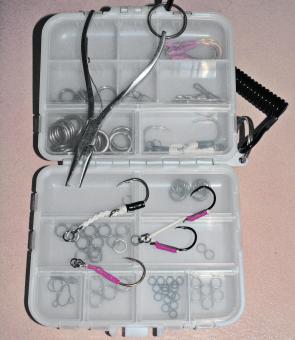
This kit contains everything needed for connecting jigs to assist hooks.
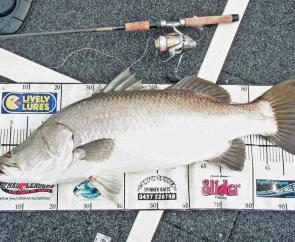
Paul Dolan from Fraser Coast Sportfishing Charters used micro jigging on schooled barra in the Boyne River.
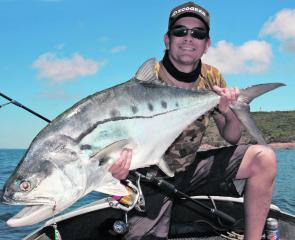
Gear for micro jigging is quite light, but the fish you will land won’t be!
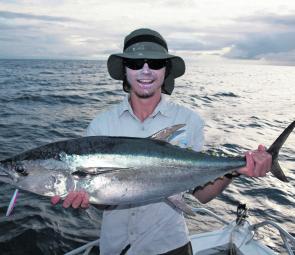
Mechanical jigging produced this longtail from the top of the water column over a wreck.
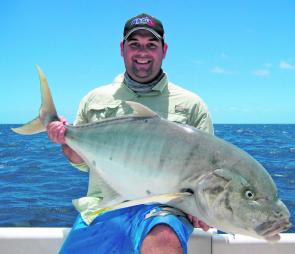
Steve Kelly with a donkey of a golden trevally micro jigged off a 3ft rise in the middle of Hervey Bay.

There are various styles and sizes of assist hooks to suit different micro jigging situations.




